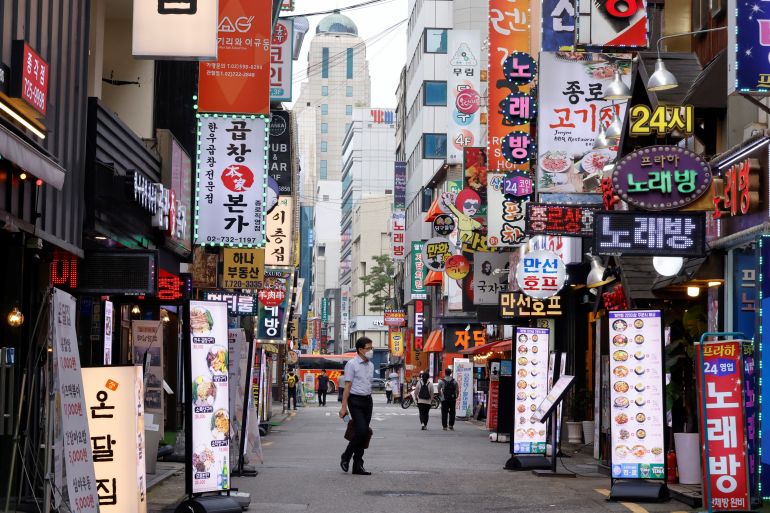New curbs across most of S Korea as COVID cases hit record high
Authorities extend social distancing rules outside the partially locked down Seoul area as COVID cases hit a new record.

South Korean authorities have announced tighter coronavirus curbs in regions outside the capital, Seoul, as daily infections hit a new record and the country battles its worst-ever outbreak, spurred by the highly contagious Delta variant.
Seoul and its neighbouring areas are already under the toughest Level 4 restrictions, which include a ban on gatherings of more than two people after 6pm. On Wednesday, Prime Minister Kim Boo-kyum said the government would now tighten rules across most of the country, with the exception of some southern regions, to Level 2 on the four-level scale.
Keep reading
list of 4 itemsSouth Korea to get 700,000 COVID shots from Israel as cases surge
Reports of people ‘starving’ as N Korea struggles to feed itself
North Korea’s Kim fumes about ‘grave lapses’ in pandemic defences
Under the new restrictions, set to come into effect on Thursday, gatherings of more than eight people are banned, and restaurants and bars must close by midnight.
Kim told an intra-agency COVID-19 meeting that the decision was reached as the number of “newly confirmed patients outside of the capital area was also on the rise”. While most of South Korea’s cases were still being recorded in and around the capital, the “average numbers of new cases from regions outside the Seoul metropolitan area have more than doubled from last week”, Kim said. He added that further curbs would be enforced in some high-risk areas.
The latest restrictions come as daily cases in South Korea soared to a record high of 1,615, a figure that surpassed the previous record of 1,378 on July 9.
“It is likely that the number will grow down the road for the time being,” said Jeong Eun-kyeong, head of the Korea Disease Control and Prevention Agency (KDCA).
For much of the pandemic, South Korea has been one of the world’s coronavirus success stories with a largely effective campaign to trace and smother clusters of infection. But the recent outbreaks have tarnished that image and shaken public confidence.
Nevertheless, South Korea’s case numbers – at 171,911 infections in all and 2,048 deaths – are still much lower than those of many other countries. The latest infections have also brought fewer deaths and cases of serious sickness because many older and more vulnerable people are now vaccinated.
But a supply shortage has slowed the vaccination campaign, according to Al Jazeera’s Rob McBride in Seoul.
“The government has been accused of being overly cautious, of not planning to get enough people vaccinated. It was always known that July would be a lean time because of vaccine supplies coming in different batches,” he said from the South Korean capital.
“And that’s what we are seeing now. There is a shortage of vaccines. But the government believes from August onwards, the increased number of shipments is going to alleviate that issue.”
According to KDCA data, the number of people getting a shot has slipped to some 30,000 a day from more than 850,000 a day in early June.
Just 30.6 percent of the 52 million population have now received at least one vaccine dose.
“At the start of the programme, there was some reticence about side effects,” said McBride. “But that seems to have been replaced by the more widespread concern about this fourth wave and the spread of the Delta variant. So, we are seeing an increase in demand for the vaccines.”
According to the KDCA, the Delta variant accounted for 30.7 percent of all new cases reported in South Korea reported from July 4 to July 10.